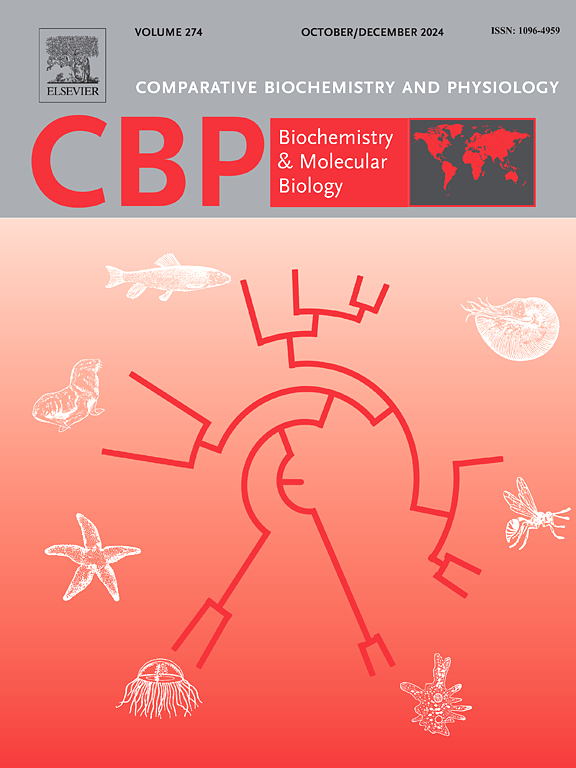中华环蚌性别分化相关基因的分子表达及其对性类固醇激素的响应
IF 1.8
3区 生物学
Q4 BIOCHEMISTRY & MOLECULAR BIOLOGY
Comparative Biochemistry and Physiology B-Biochemistry & Molecular Biology
Pub Date : 2025-08-21
DOI:10.1016/j.cbpb.2025.111148
引用次数: 0
摘要
本研究研究了中华月子性别分化相关基因的组织特异性表达和亚细胞定位,分析了激素处理(1和50 μg/L雌二醇处理(E-1、E-50)、1和50 μg/L睾酮处理(T-1、T-50)和对照组(C)对中华月子幼鱼性别比、性腺指数、肝体指数、激素含量和性别分化相关基因表达的影响。卵黄原蛋白(Vg)、睾丸特异性丝氨酸激酶1 (Tssk1)、双性和单抗-3相关转录因子1 (Dmrt1)和Wnt家族成员4 (Wnt4)在成虫性腺中显著表达,叉头盒L2 (Foxl2)和SRY-box转录因子9 (Sox9)的原位杂交信号分别定位于卵原核和卵母细胞核以及精原细胞、精母细胞和精子中。激素治疗60 d后,T-1组男女比例为7:3,但差异无统计学意义。在E-1组中,Vg在30天和120天在卵巢中高表达。在T-1组和T-50组的睾丸中,TSSK1在120天(激素治疗停止后60天)高表达。与对照组和其他激素治疗组相比,T-1组卵巢中Foxl2的表达在60天时显著升高。第120天,Sox9在睾丸中高表达。雌、睾酮浓度呈先升高后降低的趋势。综上所述,这些结果表明激素干扰了中华绒螯蟹幼鱼性别决定和性别分化基因的表达。本文章由计算机程序翻译,如有差异,请以英文原文为准。

Molecular expression of genes related to sex differentiation and their response to sex steroid hormones in the clam Chinese cyclina (Cyclina sinensis)
This study investigated the tissue-specific expression and subcellular localization of sex differentiation-related genes of Cyclina sinensis, and then analyzed the effects of hormone treatment (1 and 50 μg/L estradiol treatment (E-1, E-50), 1 and 50 μg/L testosterone (T-1, T-50), and a control group (C)) on the sex ratio, gonadosomatic index, hepatosomatic index, hormone content, and expression of sex differentiation-related genes of juvenile C. sinensis. Vitellogenin (Vg), testis-specific serine kinase 1 (Tssk1), doublesex and mab-3 related transcription factor 1 (Dmrt1), and Wnt family member 4 (Wnt4) were significantly expressed in the gonads of adult C. sinensis, and the in situ hybridization signals of forkhead box L2 (Foxl2) and SRY-box transcription factor 9 (Sox9) were localized in nuclei of oogonia and oocytes and in spermatogonia, spermatocytes, and sperm, respectively. The male to female ratio was 7:3 in group T-1 after 60 days of hormone treatment, but this effect was not statistically significant. In the E-1 group, Vg was highly expressed in the ovary at days 30 and 120. TSSK1 was highly expressed in the testes of the T-1 and T-50 groups at 120 days (60 days after the cessation of hormone treatment). The expression of Foxl2 was significantly higher in the ovaries of the T-1 group at 60 days, relative to the control and other hormone-treated groups. Sox9 was highly expressed in the testes at 120 days. The concentrations of testosterone and estradiol in the gonad of C. sinensis increased initially and then decreased. Overall, these results revealed that hormones caused disruption of sex determination and expression of sex-differentiation genes in juvenile C. sinensis.
求助全文
通过发布文献求助,成功后即可免费获取论文全文。
去求助
来源期刊
CiteScore
4.60
自引率
4.50%
发文量
77
审稿时长
22 days
期刊介绍:
Comparative Biochemistry & Physiology (CBP) publishes papers in comparative, environmental and evolutionary physiology.
Part B: Biochemical and Molecular Biology (CBPB), focuses on biochemical physiology, primarily bioenergetics/energy metabolism, cell biology, cellular stress responses, enzymology, intermediary metabolism, macromolecular structure and function, gene regulation, evolutionary genetics. Most studies focus on biochemical or molecular analyses that have clear ramifications for physiological processes.

 求助内容:
求助内容: 应助结果提醒方式:
应助结果提醒方式:


